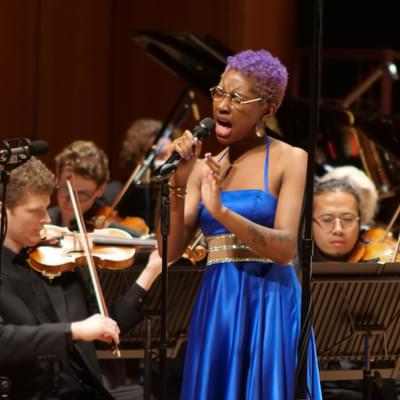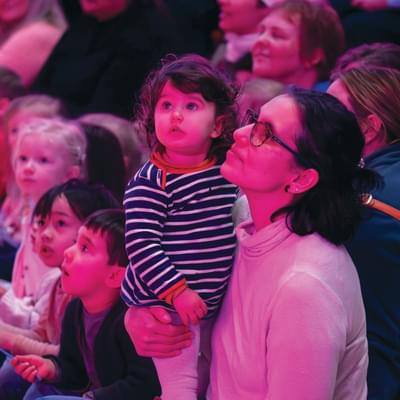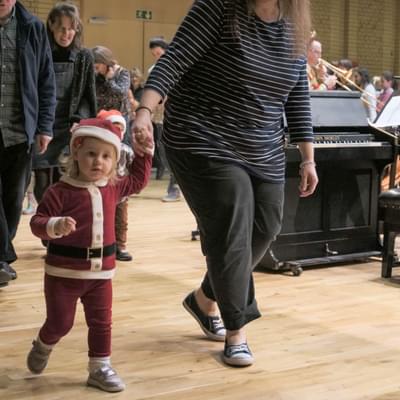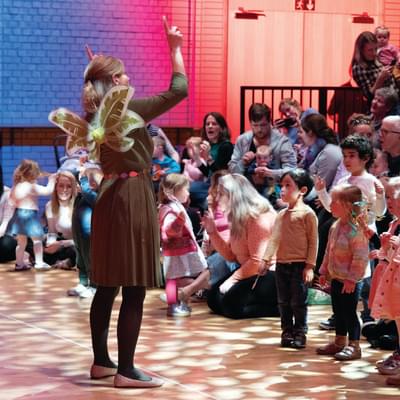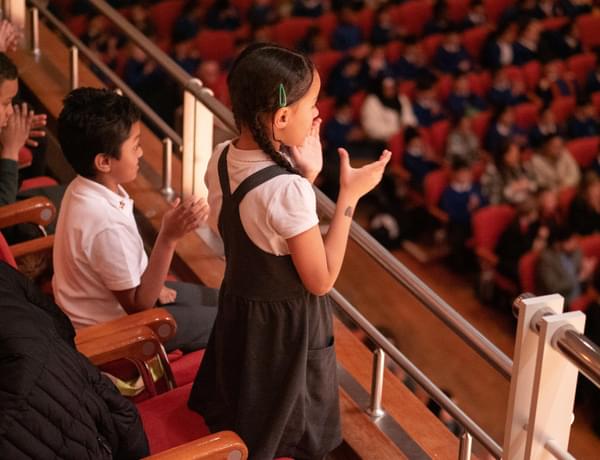
Programme Notes
MASQUERADE
Anna Clyne (born 1980)
You don’t have to be dead to write classical music – Anna Clyne is alive and well and living in Chicago (though she was born in London). She likes a cup of tea and a biscuit while she composes, and when she was getting started as a composer she worked as a waiter, a cleaner and a florist, as well as playing the cello. She doesn’t do that so much these days, though!
She wrote this piece in 2013 for the Last Night of the Proms in London: classical music’s biggest party of the year. A “Masquerade” is a party where everyone wears masks, so they can basically get up to anything they like, and she imagined London in the 18th century- full of all sorts of entertainments and crowds of fabulously dressed people, all mingling and having fun. “Acrobatics, exotic street entertainers, dancers, fireworks”, she says.
What to listen for:
Crowds - The string instruments of the orchestra seem to swirl and bustle – like people milling around in an excited crowd.
Hustle and bustle - There’s always someone moving, or something going on. Listen for how the wind instruments and string instruments seem to throw bits of music to-andfro, like jugglers – and how the brass instruments butt in and shout.
“Juice of Barley” - That’s an old London drinking song, from 1695. Anna weaves it into the music – sometimes serious, sometimes jaunty. It keeps coming back, just as you might keep seeing the same people at a fairground.
What else could I listen to?
In 2012 Anna Clyne wrote a much longer piece called Night Ferry – a sort of musical sea-journey through her dreams. It’s just as wild and colourful.
LA NUIT ET L’AMOUR
Augusta Holmès (1847-1903)
In the nineteenth century, composers and other artists called themselves Romantics. That didn’t only mean that they were interested in love (though they certainly were!). It meant that they wanted their art, above all, to portray strong human emotions: anger, joy, sorrow, calm…you name it. The titles of their pieces gave a clue to the mood, but what mattered was how the music made you feel.
Augusta Holmès lived and worked in Paris: she was a pianist, a brilliant singer, a poet and (above all) a composer. She wrote this piece in 1888 and the title means “Night and Love”…
What to listen for:
Night – the beginning is calm and quiet, like a summer night. The harp makes gentle rippling sounds, a bit like a soft breeze, or moonlight on water.
Love! – the cellos (the second-largest string instruments, held between the players knees), play a long, beautiful song without words. Is this love? How do you feel when you hear it?
Passion – slowly, Holmès adds more and more instruments as the music gets louder. Can you tell when it’s going to get loudest? And what happens then?
What else could I listen to?
There’s just so much wonderful Romantic music! To recapture that warm night-time mood, have a listen to the Rose Adagio from The Sleeping Beauty by the Russian composer Tchaikovsky.
WIND SERENADE OP.44 – FIRST MOVEMENT
Antonín Dvořák (1841-1904)
Antonin Dvořák (pronounced “vorshak”) was a Czech composer: a small, friendly man with a gruff voice, a bristly beard and a big heart (he was devoted to his wife and six children). He only got annoyed if people spelled his name wrong! And although he became one of the most famous composers of his time – both in his native Bohemia and around the world – he always remembered that he came from a humble family in the Czech countryside. “Play me some village music” he once said. “That’s what I like!”
This piece isn’t Czech village music exactly, but it sounds very like it – many Czech villages had their own bands made up of keen amateur musicians. A “Serenade” is a piece of music that’s meant to be played outside, and Dvořák wrote this one in 1878 for a group of wind instruments: a good choice if you want music to be heard outdoors (loudspeakers hadn’t been invented in 1878). It’s made up of several shorter piece (or “movements”) – this is the first.
What to listen for:
Marching on – The Serenade begins with a piece in the rhythm of a march: as if the musicians are walking out into a street or village square to begin their concert.
Odd ones out – some of the instruments are borrowed from the brass section. And two of them come from the strings. Can you tell which?
Accents – Dvořák wanted his music to sound Czech: but can music have an accent? How would you describe the sound of this music?
What else could I listen to?
The king of the wind serenade was Wolfgang Amadeus Mozart. If you love that woodwind-y sound, try his Gran Partita for 13 wind instruments!
SONATA XIII
Giovanni Gabrieli (1557-1612)
Orchestras are like time machines. Imagine Easter Day in the huge, glittering Cathedral of St Mark in medieval Venice; the people in their big ruff collars and richly coloured gowns, the priests in their golden robes, the bells tolling. From above your head, high in the Cathedral, eight brass instruments sing out…and from the other side, another group answers them like an echo.
This is the music of Giovanni Gabrieli – a sonata (which just means “something you play” in Italian) for “eight different instruments in two choirs” (before modern orchestras, composers thought of ensembles as like choirs of instruments). He wrote it when Shakespeare was active in England - but thanks to the CBSO’s brass players, and the amazing sound of Symphony Hall, you just have to close your eyes to be there: far away, and four centuries ago.
What to listen for:
Song and dance - In Gabrieli’s time, almost all music could be ether sung, or danced to. Listen or how he combines lively rhythms and smoother, more solemn music.
Echoes - The musicians are divided into two separate groups. Does one have a different character from the other?
What else could I listen to?
Across Europe, composers followed the example of Venice. The English composer Henry Purcell’s Music for the Funeral of Queen Mary is a bit sadder, but it sounds just as magnificent.
BOLÉRO
Maurice Ravel (1875-1937)
In the summer of 1928 the French composer Maurice Ravel was suddenly asked to write a lot of music very quickly. He couldn’t think of anything. But he loved the music of Spain, and he loved clockwork toys. One day, while swimming in the sea on holiday in the South of France, an idea came to him: why not combine the two ideas, then repeat them using all the different sounds of a big orchestra?
He called the result Boléro, after a kind of Spanish dance. Is it very, very simple – or very, very clever? Both – or neither? You decide. But it’s definitely very very catchy. When Boléro was first played one member of the audience stormed out, shouting “He’s mad!”. “Aha” smiled Ravel “She understands!”
What to listen for:
Machine music - it starts quietly, on the side drum…and then repeats, and repeats, and repeats. Can you count how many times?
Spanish sounds – a smokey, sultry sort of tune. First it’s played quietly by a flute on its own – then by saxophone – and then by more and more instruments until the whole orchestra is playing at full power. It’s the same tune, but it never sounds the same twice.
Twist in the tale – How is Ravel going to end it? Or is it just going to keep repeating forever? Keep listening - has a trick up his sleeve…
What else could I listen to?
There’s nothing quite like Boléro - but if you’re loving those repeated rhythms, have a listen to Mars (from The Planets) by Gustav Holst (who often conducted the CBSO back in the 1920s!)
ANGRY BIRDS
Ari Pulkkinen (b.1982) arranged by Alisdair Malloy
You might have noticed those amazing bits and pieces at the very back of the orchestra. Meet the percussion section: basically all the instruments that you bash, whack or hit. It’s sometimes called the “kitchen sink department” because percussionists have so many different types of instruments; they’ve been known to make music out of bottles, paper bags, tin cans and – you guessed it - even the kitchen sink itself! Today we’re letting them come out to the front with a tune by the Finnish composer Ari Pulkkinen - which you might just recognise…
What to listen for:
Plucking – the string players of the orchestra start things off by plucking the strings of their instruments: the musical word for this (in Italian) is pizzicato.
Eyes as well as ears – with so many different instruments to get around, percussionists have to be quick on their feet.
How many instruments – and how many players – can you see here? Bits of wood – the percussionists are playing a Xylophone (like a big keyboard made from different pieces of wood) and a Marimba (similar, but with a little help from those big tubes you see underneath it). Can you hear the difference? Why do you think that is? What else could I listen to?
What else could I listen to?
Been struck by the percussion section? Want to have your ears set tingling? Try Veni Veni Emmanuel by the Scottish composer James MacMillan.
HARRY’S WONDROUS WORLD (FROM HARRY POTTER AND THE PHILOSOPHER’S STONE)
John Williams (born 1932)
John Williams is one of the world’s best-known composers, and even if you don’t know his name, chances are you’ll know his music for films like Indiana Jones, Star Wars, War Horse and the 2001 film of Harry Potter and the Philosopher’s Stone. No composer in the world is better at using all the sounds of a big orchestra, and writing some great tunes too.
You all know the story, and we’re sure you’ll know the music when you hear it! It comes from the final credits of the film – you’ll hear Harry’s own theme and the whole orchestra at its most brilliant. John Williams never went to Hogwarts, but he can certainly conjure up some magic…
What to listen for:
Harry’s theme - The very first thing you hear. Recognise it? Film and opera composers often give characters their own tunes (or “motifs”) that reappear whenever the character appears– it helps tell the story. We all know who’s the hero here!
Wizardry - Watch and listen out for the percussion section. They’re at the very back of the orchestra, and they’re the ones who make the music seem to glitter and sparkle.
What else could I listen to?
There are thousands of great movie scores out there, and they’re just as good without the pictures. Try John Williams’ music for Star Wars: A New Hope or Jurassic Park.
SOUL BOSSA NOVA
Quincy Jones (born 1933)
Let’s boogie! The Bossa Nova is a dance from Brazil, and the name just means “New Style”. It was certainly new when the American composer Quincy Jones wrote this one in 1962. He added his own touch of “Soul” music – a style of pop music that started out in the African-American community in the 1950s, driven by unstoppable, funky rhythms and passionate emotions. He said that he wrote it in just twenty minutes. The result? Well, like it says – a Soul Bossa Nova (and if you’ve seen the Austin Powers movies, it might sound familiar). It’s hard to resist: you might find your feet taking charge!
What to listen for:
Building that beat – a simple rhythm is the first thing you hear. One by one, instruments join in: but which ones?
A taste of Brazil – the musicians of South America have created their own range of brilliant percussion instruments, and lots of them feature in this piece. Watch the back row of the orchestra and see how many you can spot!
Brass gone wild – in jazz and soul music, the trumpets and trombones can do all sorts of things that they don’t usually do in orchestras: in fact they often go a bit wild! It’s as if they’re whooping and cheering.
What else could I listen to?
Many classical and jazz composers loved the sounds of Latin America. Gershwin’s Cuban Overture and Duke Ellington’s Harlem both share that same swinging spirit.
PINES OF THE APPIAN WAY (FROM THE PINES OF ROME) (1924)
Ottorino Respighi (1879-1936)
The Italian composer Ottorino Respighi came from Bologna, but he fell in love with the magnificent city of Rome, with its art treasures, its fountains and gardens, and its centuries of history. He celebrated his new home in a series of “symphonic poems” – pieces of music that tell a story or paint a picture.
In The Pines of Rome (1924) Respighi uses a big orchestra to portray different parts of the city at different times of day. And in the final section, he imagines himself standing by the Appian Way – an ancient Roman road – and thinking back through time, as a legion of Roman soldiers marches towards the city, and enters in triumph through the gates of Rome.
What to listen for:
Distance - Composers use loudness and quietness the way painters use perspective. At first, the music is very quiet – as if very distant. As it gets closer, the music gets louder.
Marching - That means a steady, regular rhythm – the tramping of feet, and thousands of armoured warriors. At first it’s vague and blurry-sounding – that’s to say, distant.
Setting the Scene - In the quiet, the cor anglais and bassoon play sad, winding tunes – like shepherds by the roadside, playing their pipes.
Triumph - As the legion marches into view, the sound is awesome. The brass and percussion don’t just make the sound of military musicians: their sound seems to glitter and gleam, like sunlight on swords and helmets.
What else could I listen to?
Respighi wrote two more orchestral tributes to Rome: The Fountains of Rome and Roman Festivals.
THE COMPOSERS
Name: Anna Clyne (born 1980 - age 43)
Nationality: British
Interesting Facts:
• Anna is a gifted painter, and likes to create pictures of her music.
• She grew up in London and wrote her first piece when she was seven.
• During lockdown, she taught herself to play the banjo.
• She’s a big fan of classic rock and jazz: her favourites include The Rolling Stones and Nina Simone
► What could music look like, if you tried to draw or paint it?
► Have you ever written any of your own music? How old were you when you started?
Name: Augusta Holmès (1847-1903)
Nationality: French
Interesting Facts:
• She was born in Paris, but her parents were both Irish – and her mother was a poet.
• She hung out with poets, artists, musicians and politicians, and might have worked as a secret agent.
• Early in her career, she pretended that her music was written by a man called Hermann Zenta.
► Can you tell what nationality a composer is from their music?
► Why might a woman composer in the nineteenth century pretend to be a man?
Name: Antonín Dvořák (1841-1904)
Nationality: Czech
Interesting Facts:
• Dvořák’s father was an innkeeper and also worked as a butcher.
• When he wasn’t composing, Dvořák was a keen trainspotter and also kept pet pigeons.
• Dvořák visited Birmingham twice, and performed in the Town Hall. He loved it: “this great city, where they make knives, scissors, springs – and music too!”
► Can you think of any other famous musicians who’ve visited Birmingham?
► Do you have any hobbies (apart from music)?
Name: Giovanni Gabrieli (1554/7 – 1612)
Nationality: Italian
Interesting Facts:
• He was born and spent most of his life in Venice, but he also worked in Germany.
• He was a superstar in his own lifetime – one listener said his music was “so good, so delectable, so super-excellent”.
• He played the lute, and once wrote a piece for seven organs.
• Gabrieli died of a kidney stone – easily treated today but deadly then.
► Why don’t we know exactly when Gabrieli was born?
► Have you ever travelled to make music?
Name: Maurice Ravel (1875-1937)
Nationality: French
Interesting Facts:
• Ravel’s father was a slightly mad inventor who created a fairground ride called “The Whirlwind of Death”. It was about as safe as it sounds…
• He loved toys and lived in a house full of gadgets, ornaments and clockwork models.
• Ravel enjoyed English cooking and always ate steak and kidney pudding when in London.
• His opera L’enfant et les sortilèges stars a cat, a squirrel and a singing teapot.
► What kind of food puts you in the mood to be creative?
► What would a teapot sound like, if it could sing?
Name: Quincy Jones (b.1933 – age 90)
Nationality: American
Interesting Facts:
• His father was a baseball player whose middle name was Delight.
• He’s known to everyone in the business as “Q”
• Studied in Paris with the French composer Nadia Boulanger – who taught over 600 classical, jazz and pop composers.
• He’s written more than 40 movie scores and as a record producer he’s worked with Donna Summer, Frank Sinatra and Aretha Franklin.
• Q starred as himself in the movie Austin Powers in Goldmember
► What makes a great music teacher?
► Is there a difference between pop and classical music?
Name: Ari Pulkkinen (b.1982 – age 42)
Nationality: Finnish
Interesting Facts:
• A keen gamer, he never meant to be a composer – he got into it when a friend asked him to help with a game he was writing.
• A keen gamer, he never meant to be a composer – he got into it when a friend asked him to help with a game he was writing.
• His own favourite games include Monkey Island, Fallout and The Elder Scrolls: Skyrim.
• Ari relaxes by going to his lakeside cabin in the forest and “fishing, building something, drinking some beers”.
► Why do games need music?► How is gaming music different from film music?
Name: John Williams (born 1932 – age 92)
Nationality: American
Interesting Facts:
• He started out by playing piano in the band of the US Air Force – and playing jazz in New York clubs.
• Only Walt Disney has ever been nominated for more Oscars than John Williams.
• He’s the oldest person ever to have been nominated for an Academy Award (when he was 90).
• He can play piano, bassoon, cello, clarinet, trombone, and trumpet.
► What instrument(s) can you play?
► What’s your favourite piece of film music, and why?
Name: Ottorino Respighi (1879-1936)
Nationality: Italian
Interesting Facts:
• He could read eleven languages and taught himself to play the harp in seven days.
• He was born in Bologna (the home of Bolognese sauce) but travelled to Russia to study music.
• Fascinated by science – he was good friends with Albert Einstein.
• Respighi would party all night after concerts – he was an expert at making cocktails and would order up spaghetti for everybody at 3am.
► Italy has produced many famous classical composers – as well as Gabrieli and Respighi, how many can you name?
► Italy has produced many famous classical composers – as well as Gabrieli and Respighi, how many can you name?
TIMELINE
1612 Gabrieli: Sonata XIII.
1616 Shakespeare dies.
1635 Aston Hall built.
1740 First known orchestral concerts in Birmingham.
1767 Joseph Priestley invents soda water – the world’s first fizzy drink.
1776 The American colonies declare Independence from Britain, founding the USA.
1783 First animal flies in the Montgolfier Brothers’ hot air balloon: a (confused) sheep.
1789 The French Revolution begins 26 years of wars across Europe.
1815 Battle of Waterloo.
1824 John Cadbury opens his first chocolate shop in Birmingham.
1838 The railway from London reaches Birmingham.
1865 Lewis Carroll writes Alice in Wonderland.
1878 Dvorák: Wind Serenade.
1888 Holmès: La nuit et l’amour.
1905 Cadbury invents Dairy Milk.
1913 Mathematician Emile Borel describes the Infinite Monkey Theorem.
1914-18 World War One.
1920 The City of Birmingham Symphony Orchestra gives its first ever concert!
1924 Respighi: Pines of the Appian Way.
1928 Ravel: Boléro.
1937 JRR Tolkien writes The Hobbit.
1939-45 World War Two.
1955 First McDonald’s opens in America.
1962 Jones: New Soul Bossa Nova.
1969 Humans land on the Moon for the first time.
1976 A plague of millions of ladybirds strikes the UK.
1989 First episode of The Simpsons. Democratic revolutions in Eastern Europe.
1991 The world’s first website goes live.
1997 Harry Potter and the Philosopher’s Stone is published.
2001 Williams: Harry’s Wondrous World.
2003 Dolly, the world’s first cloned sheep, dies in Edinburgh at the age of 6.
2009 Pulkkinen: Angry Birds.
2013 Clyne: Masquerade.
2016 TikTok launched, in China.
2020 Worldwide Coronavirus pandemic – masks, jabs and lockdowns…
2021 George the Ginger Cat appointed chief mouser at Stourbridge Junction Railway Station.
2022 Birmingham hosts Commonwealth Games. Death of Queen Elizabeth II.
2024 Birmingham school students hear the CBSO at Symphony Hall – and it rocks their world.
THANK YOU
These concerts have been possible with generous support from Deloitte, Services for Education; the Scops Arts Trust, The Saintbury Trust and all those who have contributed to the CBSO’s public appeal; and the Clive Richards Foundation, principal supporter of the CBSO’s work with young people.
More events coming up...
What's on
Project Remix
